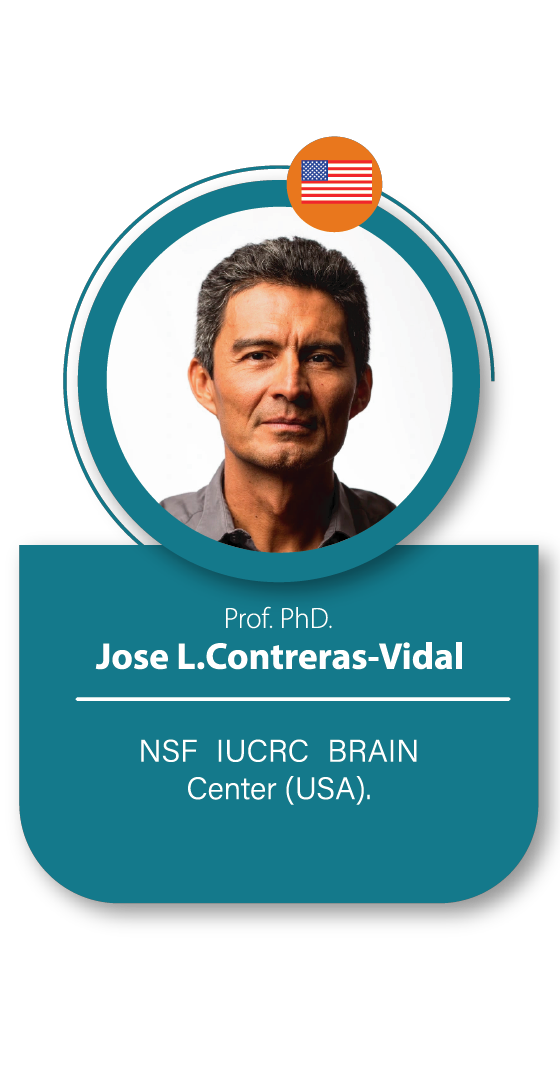
TBA
Paula Herrara Gomez, Medical doctor degree from Universidad Tecnológica de Pereira (2001), General Psychiatry (2010) and Child Psychiatrist (2012) from Paris University 7 and 5, master’s degree in Neuropsychology for research (Grenoble, France, 2012), Ph.D. in Neuroscience (Versailles, France, 2015). Leader of the research group "Psychiatry, Neuroscience and Community (PSINECO)", attached to Universidad Tecnologica de Pereira

TBA
Jose L.Contreras-Vidal, he earned his Engineer’s degree from the Tecnologico de Monterrey (Mexico), the MSEE degree at the University of Colorado – Boulder, and a Ph.D. degree in Cognitive and Neural Systems from Boston University in 1994. He pursued postdoctoral training in computational clinical neuroscience at Arizona State University and the University of Fribourg (Switzerland). He was a fellow of the Instituto Iberoamericano, the Human Frontier Science Program (HFSP), the International Brain Research Organization (IBRO), and the Institut National de la Santé et de la Recherche Médicale (INSERM). He was a City of Paris Senior Fellow pursuing neuroimaging research at UMR-742 INSERM, Université Pierre et Marie Curie, Paris, France. Dr. Contreras-Vidal is the Founder and Director of the Industry-University Cooperative Research Center for Building Reliable Advances and Innovations in Neurotechnologies (IUCRC BRAIN) at the University of Houston funded in part by the National Science Foundation. He is also the PI and Director of the NSF REU Site Neurotechnologies to Help the Body Move, Heal, and Feel Again, to provide research opportunities for undergraduate students from under-represented groups. Dr. Contreras-Vidal was elected to the rank of Fellow by the Institute of Electrical and Electronics Engineers (IEEE) for his contributions to brain-machine interfaces (BMI) and wearable exoskeletons and to the College of Fellows of the American Institute of Medical and Biological Engineers (AIMBE) for pioneering contributions to the development of brain-machine interfaces for controlling wearable exoskeletons for rehabilitation, and for mapping art-evoked brain activity. Dr. Contreras-Vidal regularly serves in NSF and NIH review panels and he is currently a member of the NIH’s National Advisory Board on Medical Rehabilitation Research (NABMRR). The Board advises the directors of NIH, NICHD, and the National Center for Medical Rehabilitation Research (NCMRR) on matters and policies relating to NCMRR’s programs. He also serves in the editorial boards of IEEE Human Machine Systems, Frontiers in Neuroprosthetics, the International Journal of Mobile Computer Interaction, and Brain-Computer Interfaces. Dr. Contreras-Vidal’s innovative and transformative research in BMI, neuroprosthetics, and wearable exoskeletons has led to four patents (US 11,052,249, US 20150012111 A1, US D783820 S1, and US 9468541) and 2 patents pending (WO2017218661A1; PCT/US2017/037457). Dr. Contreras-Vidal has been a PI on federally funded grants (NIH, NSF, DARPA) for 20+ years, and his work has also been supported by industry and foundations. Dr. Contreras-Vidal’s research is highlighted regularly in the scientific and public media, including The Economist, NPR, Nature, Science, New York Times, National Public Radio, the Society for Neuroscience, and the Wall Street Journal to name a few. His career in biomedical engineering has been profiled in Science.

TBA
Catalina Alvarado, her main research interest is to develop technological tools to support the diagnosis and treatment of neurological diseases. her areas of work are biomedical processing, machine learning and biomedical instrumentation instrumentation. She applied the tools of these areas to the analysis of electroencephalography signals, electromyography neuroimaging and MOCAP signals in neurological diseases (epilepsy, Parkinson's, stroke, among others), as well as in the development of human-machine interfaces, which provide innovative technological solutions in the field of neurosciences, neurology and neurorehabilitation.

TBA
Norberto Garcia-Cairasco, BSc in Biology (1976) at Universidad del Valle, Cali, Valle del Cauca, Colombia, MD (1982) and PhD (1985) in Physiology-Neurophysiology at Ribeirão Preto Sch. Med. University of São Paulo, Ribeirão Preto, SP, Brazil. Postdoctoral 1988-1990 Neurology – Epilepsy at Duke University Medical Center, Durham, NC, USA. He acts in the field of Physiology-Neurophysiology, mainly in an integrated form in the following themes: Behavioral, Electrophysiological, and Molecular Evaluation of Alterations of the Motor Control, among them Epilepsies, Obsessive Compulsive Disorder, Parkinson´s and Alzheimer´s diseases, mostly in experimental models. I study also Auditory Plasticity, Sensory-Motor and Sensory-Limbic integration, and Complex Systems in Neurosciences. More than 33 years of experience at USP, published more than 130 articles, 9 book chapters. He did seminal studies with detailed characterization of behavioral sequences displayed by rats with acute and chronic audiogenic seizures, in Status Epilepticusand electrical amygdala kindling. He also pioneered the use of neuroethology and complexity (graph analysis) in behavioral sequences of temporal/frontal lobe seizures in patients from our Epilepsy Surgery Center. Synchronized video-EEG protocols helped to characterize endogenous anticonvulsant systems. Using neuroanatomical, molecular biology, cardiovascular/respiratory, and neuroendocrine physiology, as well as microscopy protocols we integrate models into different levels of complexity. He has graduated twenty-two (22) Ph.D. students and fifteen (15) MSc students, supervised 7 Post-Docs, and has five PhD/MSc students currently under supervision. In fact, from 2013 to 2016, he was the Director of the Ph.D. Program in Physiology, at the School of Medicine and because of its impact in the formation of hundreds of PhDs in Physiology (1973-2019), the most important historically in Brazil.

TBA
Marta Molinas (Senior Member, IEEE) received the Diploma degree in electromechanical engineering from the National University of Asuncion, Asuncion, Paraguay, in 1992, the M.E. degree from Ryukyu University, Nishihara, Japan, in 1997, and the D.Eng. degree from the Tokyo Institute of Technology, Tokyo, Japan, in 2000. She was a Guest Researcher with the University of Padua, Padova, Italy, in 1998. From 2004 to 2007, she was a Post-Doctoral Researcher with the Norwegian University of Science and Technology (NTNU), Trondheim, Norway, where she was a Professor with the Department of Electric Power Engineering, from 2008 to 2014. She is currently a Professor with the Department of Engineering Cybernetics, NTNU. Starting in 2015 and after 12 years of working on the stability of power electronics systems, she has gradually expanded her research area into non-linear and non-stationary signal analysis, from the domain of harmonics in power systems into the domain of biological systems, specifically EEG signals. For that purpose, her group is now developing computational models of the human brain for solving the EEG inverse problem and generic platforms for non-linear and non-stationary signals analysis suitable for both physical and biological systems (electrical grids, EEG signals). Molinas is an Editor of the IEEE Journal of Emerging and Selected Topics in Power Electronics, Associate Editor of the IEEE Transactions on Power Electronics, and an Editor of the IEEE Transactions on Energy Conversion. She has been an AdCom Member of the IEEE Power Electronics Society from 2009 to 2011.

TBA
SalvadorDura-Bernal, he completed his Ph.D. and first post-doctoral fellowship at the University of Plymouth, UK; followed by post-doctoral research at Johns Hopkins and SUNY Downstate. His research focuses on understanding cortical circuits through large-scale biophysically-detailed simulations on supercomputers. Dr. Dura-Bernal has developed detailed models of motor and auditory cortical circuits by integrating experimental data available at multiple scales -- molecules, neurons, networks, and systems. The models provided insights into cortical dynamics and helped develop new hypotheses and guide experimentation. He also developed a software tool (www.netpyne.org) for the multiscale modeling of brain circuits. It has already been used worldwide in over 40 labs, to train students and to investigate different brain regions and phenomena. Dr. Dura-Bernal has published over 30 peer-reviewed papers and was invited to present his work at the 2018 Google Next supercomputing conferences in London and San Francisco. He received the 2019 Robert Furchgott Scholar Award for Excellence in Research, an early career investigator prize; and the 2017 Best Use of AI Award from HPCwire, a leading supercomputing publication. Dr. Dura-Bernal has obtained funding for his research from the NY State Spinal Cord Injury Board, the National Institutes of Health (NIH), and the National Science Foundation (NSF). In 2019 he was awarded a 5-year $1.2 million NIH grant (single PI) on multiscale modeling of brain circuits. As an educator, Dr. Dura-Bernal developed a new curriculum in Computational Neuroscience and has taught this course at SUNY Downstate and NYU. He is regularly invited to teach international courses and tutorials. Dr. Dura-Bernal mentors and trains several postdocs, graduate students, and interns in the lab. He is committed to outreach and diversity, which made him join the NY Academy of Science STEM program to teach neuroscience to underrepresented middle school students in Brooklyn.

TBA
Fabien Lotte obtained a M.Sc., a M.Eng. and a PhD degree in computer sciences, all from the National Institute of Applied Sciences (INSA) Rennes, France, in 2005 (M.Sc., M.Eng.) and 2008 (PhD). His PhD Thesis received both the PhD Thesis award 2009 from AFRIF (French Association for Pattern Recognition) and the PhD Thesis award 2009 accessit (2nd prize) from ASTI (French Association for Information Sciences and Technologies). In 2009 and 2010, he was a research fellow at the Institute for Infocomm Research (I2R) in Singapore, working in the Brain-Computer Interface Laboratory. From January 2011 to September 2019, he was a Research Scientist (with tenure) at Inria Bordeaux Sud-Ouest, France, in team Potioc (http://team.inria.fr/potioc/). He obtained an Habilitation (HDR) in Computer Science from the University of Bordeaux in September 2016. Between October 2016 and January 2018, he spent 1-year as a visiting scientist at RIKEN Brain Science Institute, Japan, in Cichocki's laboratory for advanced brain signal processing. Since October 2019, he is a Research Director (DR2) at Inria Bordeaux Sud-Ouest, France, still in team Potioc. His research interests include Brain-Computer Interfaces (BCI), human-computer interaction, pattern recognition and brain signal processing. He is part of the editorial boards of the journals Brain-Computer Interfaces (since 2016), Journal of Neural Engineering (since 2016) and IEEE Transactions on Biomedical Engineering (since 2021). He is also co-specialty chief editor of Frontiers in Neuroergonomics: Neurotechnology and System Neuroergonomics. He co-edited the books "Brain-Computer Interfaces 1: foundations and methods" and "Brain-Computer Interfaces 2: technology and applications", published both in French and in English in 2016, as well as the book "Brain-Computer Interfaces Handbook: Technological and Theoretical Advance" published in 2018 . In 2016, he was the recipient of an ERC Starting Grant (project BrainConquest) to develop his research on BCI.

TBA
Alexandre Surget, following an early career training in Neurobiology and Psychopharmacology (University of Tours, France – M.Sc, PhD 2008), Alexandre SURGET worked at the Universidad de Antioquia (Medellin, Colombia) as a visiting professor in 2009 and at the Kavli Institute for Systems Neuroscience of NTNU (Trondheim, Norway) as an IBRO and Marie Curie postdoctoral Fellow in 2010-2013, where he extended his area of expertise to electrophysiology and neural dynamics. Endowed with the Lord Kelvin Adam Smith (LKAS) leadership award, he joined in 2013 the Institute of Neuroscience and Psychology at the University of Glasgow as a principal investigator and, from 2016, the University of Tours as an Associate Professor working at the INSERM research centre iBraiN where he now leads the team “Experimental and Translational Psychiatry”. Alexandre SURGET has dedicated his research to the elucidation of the neurobiological mechanisms underlying stress integration, stress-related disorders and their treatments. His research particularly aims to provide a mechanistic framework explaining population dynamics and computations within the hippocampal formation, and how they operate and affect larger systems to produce normal or pathological brain functions. One of his major accomplishments rests on unravelling the functional involvement of adult hippocampal neurogenesis in stress response and antidepressant effects. He also contributed through translational approaches to identify molecular and neural signatures of depression in mouse models, highly conserved in humans, establishing new avenue for preventive and therapeutic developments, including targeted focal ultrasound neurostimulations. All his achievements are reflected by a strong track record in high impact journals and citations as well as by the attribution of many research fellowships and awards (French Society for Neuroscience’s PhD prize, FP7 EC Marie Curie, IBRO, Fyssen, Fondation pour la Recherche Medicale, Fondation de France, Bettencourt-Schueller Foundation, LKAS, SULSA Leader).

TBA
Dr. Marangelie Criado-Marrero is a research assistant professor at the University of Florida. She earned a BS in biomedical sciences from the University of Puerto Rico and a dual master's degree in health sciences and healthcare business administration from TUI University. Her Ph.D. and postdoctoral experience were devoted to investigating the association of trauma, neurodegeneration, and neuropsychiatric disorders. The goal of her current research is to investigate molecular mechanisms, characterize anatomical features and describe complex brain networks linking trauma brain injuries with dementia. Using an animal model, she applies graph theory metrics to better understand how brain interactions at a global (network) and local (regions) levels are affected following a trauma brain injury. This knowledge is essential to understand how injuries increase the risk for mental and neurodegenerative diseases such as post-traumatic stress disorder and Alzheimer’s disease. This work aims to facilitate a profile of early pathological features occurring post-injuries to ensure improved health outcomes and a more favorable time for medical intervention. She is a passionate educator who enjoys mentoring students and participating in outreach activities to promote the value of scientific research in our community.